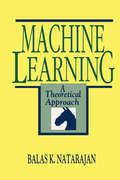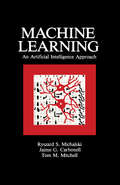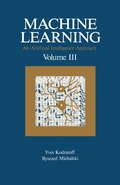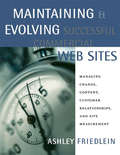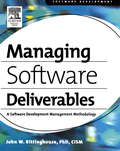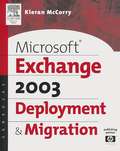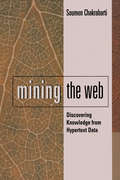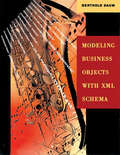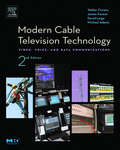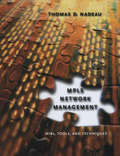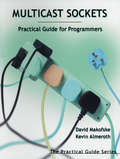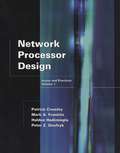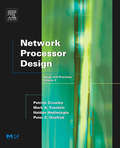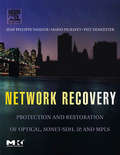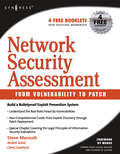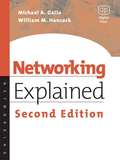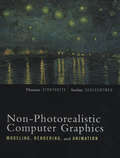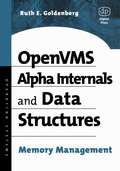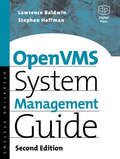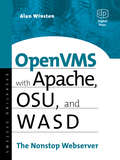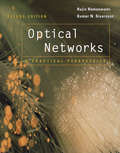- Table View
- List View
Machine Learning: A Theoretical Approach
by Balas K. NatarajanThis is the first comprehensive introduction to computational learning theory. The author's uniform presentation of fundamental results and their applications offers AI researchers a theoretical perspective on the problems they study. The book presents tools for the analysis of probabilistic models of learning, tools that crisply classify what is and is not efficiently learnable. After a general introduction to Valiant's PAC paradigm and the important notion of the Vapnik-Chervonenkis dimension, the author explores specific topics such as finite automata and neural networks. The presentation is intended for a broad audience--the author's ability to motivate and pace discussions for beginners has been praised by reviewers. Each chapter contains numerous examples and exercises, as well as a useful summary of important results. An excellent introduction to the area, suitable either for a first course, or as a component in general machine learning and advanced AI courses. Also an important reference for AI researchers.
Machine Learning: An Artificial Intelligence Approach (Volume I)
by Ryszard S. Michalski Jaime G. Carbonell Tom M. MitchellMachine Learning: An Artificial Intelligence Approach contains tutorial overviews and research papers representative of trends in the area of machine learning as viewed from an artificial intelligence perspective. The book is organized into six parts. Part I provides an overview of machine learning and explains why machines should learn. Part II covers important issues affecting the design of learning programs—particularly programs that learn from examples. It also describes inductive learning systems. Part III deals with learning by analogy, by experimentation, and from experience. Parts IV and V discuss learning from observation and discovery, and learning from instruction, respectively. Part VI presents two studies on applied learning systems—one on the recovery of valuable information via inductive inference; the other on inducing models of simple algebraic skills from observed student performance in the context of the Leeds Modeling System (LMS). This book is intended for researchers in artificial intelligence, computer science, and cognitive psychology; students in artificial intelligence and related disciplines; and a diverse range of readers, including computer scientists, robotics experts, knowledge engineers, educators, philosophers, data analysts, psychologists, and electronic engineers.
Machine Learning: An Artificial Intelligence Approach, Volume III
by Yves Kodratoff Ryszard S. MichalskiMachine Learning: An Artificial Intelligence Approach, Volume III presents a sample of machine learning research representative of the period between 1986 and 1989. The book is organized into six parts. Part One introduces some general issues in the field of machine learning. Part Two presents some new developments in the area of empirical learning methods, such as flexible learning concepts, the Protos learning apprentice system, and the WITT system, which implements a form of conceptual clustering. Part Three gives an account of various analytical learning methods and how analytic learning can be applied to various specific problems. Part Four describes efforts to integrate different learning strategies. These include the UNIMEM system, which empirically discovers similarities among examples; and the DISCIPLE multistrategy system, which is capable of learning with imperfect background knowledge. Part Five provides an overview of research in the area of subsymbolic learning methods. Part Six presents two types of formal approaches to machine learning. The first is an improvement over Mitchell's version space method; the second technique deals with the learning problem faced by a robot in an unfamiliar, deterministic, finite-state environment.
Maintaining and Evolving Successful Commercial Web Sites: Managing Change, Content, Customer Relationships, and Site Measurement (The Morgan Kaufmann Series in Data Management Systems)
by Ashley FriedleinAshley Friedlein's first book, Web Project Management: Delivering Successful Commercial Web Sites, became a bestseller and an essential reference for Web professionals developing new sites. Maintaining and Evolving Successful Commercial Web Sites addresses the realities of successful sites today, namely the notion that maintaining and evolving a site is actually a bigger commitment than launching it. Management wants to maximize returns and obtain reliable performance data, customers demand better service and insist on sites that are more advanced yet easier to use, and the Web site must increasingly be integrated with the entire business even as the amount of information it handles continues to grow.Maintaining and Evolving Successful Commercial Web Sites focuses more on process, reality, and pragmatism and less on strategic theory. It provides the reader with the knowledge, tools, approaches, and processes to manage key site maintenance and evolution projects, providing answers to the following questions:*How can I better manage changes and updates to the Web site?*How can I scale up to allow more contributions to the site and more content and still maintain quality and control?*What is content management and how do I go about it?*How do I go about personalization or community building?*What is Customer Relationship Management (CRM) and how do I actually do it online?*How do I measure and report on how well the site is doing?*How do I avoid information overload?*How do I maximize the value the site creates?The book includes case studies to demonstrate candidly how the issues discussed in the book translate into reality.*Case studies show candidly how the issues discussed translate into reality. *Describes content management & Customer Relationship Management (CRM) how to go about implementing them. *Teaches how to measure & report on how well the site is doing, how to avoid information overload, & how to maximize the value the site creates.
Managing Software Deliverables: A Software Development Management Methodology
by John Rittinghouse, PhD, CISMManaging Software Deliverables describes a set of proven processes for establishing an effective Software Program Management Office (SPMO) function in a corporate setting. Every business that has people performing Software Project Management (PM) activities has a need for these processes. In some instances, an organization may already have a PMO chartered with overall responsibility for each project managed in an enterprise. In those cases, this book will either provide validation of their efforts or it will provide some techniques and useful approaches that can be utilized to further improve on their overall implementation of the PMO. In the vast majority of cases in business, however, a PMO is unheard of. Each project managed in the enterprise is unfortunately managed separately from all others (at great cost in both time and money to the enterprise).Phase Roadmaps clearly depict what is expected by all parties at each phase of effortPre-built Intranet is ready to deploy in a corporate setting and provides immediate useProcess Methodology adheres to proven best-practices for software development
Microsoft® Exchange Server 2003 Deployment and Migration (HP Technologies)
by Kieran McCorryMicrosoft® Exchange Server 2003 Deployment and Migration describes everything that you need to know about designing, planning, and implementing an Exchange 2003 environment. The book discusses the requisite infrastructure requirements of Windows 2000 and Windows 2003. Furthermore, this book covers, in detail, the tools and techniques that messaging system planners and administrators will require in order to establish a functioning interoperability environment between Exchange 2003 and previous versions of Exchange including Exchange 5.5 and Exchange 2000. Since Microsoft will drop support for Exchange 5.5 in 2004, users will have to migrate to Exchange 2003. Additionally the book describes various deployment topologies and environments to cater for a multitude of different organizational requirements.* Details for consultants and system administrators to migrate from older versions of Exchange 5.5 and Exchange 2000* Critical information on integration with Outlook 2003 and Windows 2003* Based on actual implementations of both beta and final release versions of Exchange 2003 in larger enterprise environments
Minimalist Mobile Robotics
by Jonathan H. ConnellRather than using traditional artificial intelligence techniques, which are ineffective when applied to the complexities of real-world robot navigaiton, Connell describes a methodology of reconstructing intelligent robots with distributed, multiagent control systems. After presenting this methodology, hte author describes a complex, robust, and successful application-a mobile robot "can collection machine" which operates in an unmodified offifce environment occupied by moving people.
Mining the Web: Discovering Knowledge from Hypertext Data (The Morgan Kaufmann Series in Data Management Systems)
by Soumen ChakrabartiMining the Web: Discovering Knowledge from Hypertext Data is the first book devoted entirely to techniques for producing knowledge from the vast body of unstructured Web data. Building on an initial survey of infrastructural issues—including Web crawling and indexing—Chakrabarti examines low-level machine learning techniques as they relate specifically to the challenges of Web mining. He then devotes the final part of the book to applications that unite infrastructure and analysis to bring machine learning to bear on systematically acquired and stored data. Here the focus is on results: the strengths and weaknesses of these applications, along with their potential as foundations for further progress. From Chakrabarti's work—painstaking, critical, and forward-looking—readers will gain the theoretical and practical understanding they need to contribute to the Web mining effort.* A comprehensive, critical exploration of statistics-based attempts to make sense of Web Mining.* Details the special challenges associated with analyzing unstructured and semi-structured data.* Looks at how classical Information Retrieval techniques have been modified for use with Web data.* Focuses on today's dominant learning methods: clustering and classification, hyperlink analysis, and supervised and semi-supervised learning.* Analyzes current applications for resource discovery and social network analysis.* An excellent way to introduce students to especially vital applications of data mining and machine learning technology.
Modeling Business Objects with XML Schema (The Morgan Kaufmann Series in Software Engineering and Programming)
by Berthold DaumXML Schema is the new language standard from the W3C and the new foundation for defining data in Web-based systems. There is a wealth of information available about Schemas but very little understanding of how to use this highly formal specification for creating documents. Grasping the power of Schemas means going back to the basics of documents themselves, and the semantic rules, or grammars, that define them. Written for schema designers, system architects, programmers, and document authors, Modeling Business Objects with XML Schema guides you through understanding Schemas from the basic concepts, type systems, type derivation, inheritance, namespace handling, through advanced concepts in schema design.*Reviews basic XML syntax and the Schema recommendation in detail.*Builds a knowledge base model step by step (about jazz music) that is used throughout the book.*Discusses Schema design in large environments, best practice design patterns, and Schema's relation to object-oriented concepts.
Modeling Embedded Systems and SoC's: Concurrency and Time in Models of Computation (ISSN)
by Axel JantschOver the last decade, advances in the semiconductor fabrication process have led to the realization of true system-on-a-chip devices. But the theories, methods and tools for designing, integrating and verifying these complex systems have not kept pace with our ability to build them. System level design is a critical component in the search for methods to develop designs more productively. However, there are a number of challenges that must be overcome in order to implement system level modeling. This book directly addresses that need by developing organizing principles for understanding, assessing, and comparing the different models of computation necessary for system level modeling. Dr. Axel Jantsch identifies the representation of time as the essential feature for distinguishing these models. After developing this conceptual framework, he presents a single formalism for representing very different models, allowing them to be easily compared. As a result, designers, students, and researchers are able to identify the role and the features of the "right" model of computation for the task at hand.*Offers a unique and significant contribution to the emerging field of models of computation *Presents a systematic way of understanding and applying different Models of Computation to embedded systems and SoC design*Offers insights and illustrative examples for practioners, researchers and students of complex electronic systems design.
Modern Cable Television Technology (ISSN)
by David Large James FarmerFully updated, revised, and expanded, this second edition of Modern Cable Television Technology addresses the significant changes undergone by cable since 1999--including, most notably, its continued transformation from a system for delivery of television to a scalable-bandwidth platform for a broad range of communication services. It provides in-depth coverage of high speed data transmission, home networking, IP-based voice, optical dense wavelength division multiplexing, new video compression techniques, integrated voice/video/data transport, and much more. Intended as a day-to-day reference for cable engineers, this book illuminates all the technologies involved in building and maintaining a cable system. But it's also a great study guide for candidates for SCTE certification, and its careful explanations will benefit any technician whose work involves connecting to a cable system or building products that consume cable services.Written by four of the most highly-esteemed cable engineers in the industry with a wealth of experience in cable, consumer electronics, and telecommunicationsAll new material on digital technologies, new practices for delivering high speed data, home networking, IP-based voice technology, optical dense wavelength division multiplexing (DWDM), new video compression techniques, and integrated voice/video/data transportCovers the latest on emerging digital standards for voice, data, video, and multimediaPresents distribution systems, from drops through fiber optics, an covers everything from basic principles to network architectures
MPLS Network Management: MIBs, Tools, and Techniques (ISSN)
by Thomas D. NadeauMPLS-enabled networks are enjoying tremendous growth, but practical information on managing MPLS-enabled networks has remained hard to find. Until now. MPLS Network Management: MIBs, Tools, and Techniques is the first and only book that will help you master MPLS management technologies and techniques, as they apply to classic MPLS networks, traffic-engineered networks, and VPNs. Written by the co-author of most current MPLS management standards, it provides detailed, authoritative coverage of official MIBs, examining key topics ranging from syntax to access levels to object interaction. It also offers extensive consideration of third-party management interfaces, including tools for metering traffic and predicting traffic growth and behavior. If you're a network operator, network device engineer, or MPLS application developer, you need this book to get all you can out of all of MPLS's many capabilities.* The only book devoted entirely to the tools and techniques for controlling, monitoring, debugging, and optimizing MPLS-enabled networks. * Authoritative information from the co-author of most IETF MIBs relating to MPLS and GMPLS, PWE3, and PPVPN. * Covers both standards-based and proprietary management technologies. * Includes interviews with seminal figures in the development of MPLS. * Via a companion web site, provides information on late-breaking developments in MPLS management and links to additional resources. * To be followed by a second volume presenting best-practice case studies dealing with how real companies approach the management of their MPLS networks.
Multicast Sockets: Practical Guide for Programmers (The Practical Guides)
by David Makofske Kevin AlmerothMulticast Sockets: Practical Guide for Programmers is a hands-on, application-centric approach to multicasting (as opposed to a network-centric one) that is filled with examples, ideas, and experimentation. Each example builds on the last to introduce multicast concepts, frameworks, and APIs in an engaging manner that does not burden the reader with lots of theory and jargon. The book is an introduction to multicasting but assumes that the reader has a background in network programming and is proficient in C or Java. After reading the book, you will have a firm grasp on how to write a multicast program.Author team of instructor and application programmer is reflected in this rich instructional and practical approach to the subject materialOnly book available that provides a clear, concise, application-centric approach to programming multicast applications and covers several languages—C, Java, and C# on the .NET platformCovers important topics like service models, testing reachability, and addressing and scopingIncludes numerous examples and exercises for programmers and students to test what they have learned
Network Processor Design: Issues and Practices (ISSN)
by Mark A. Franklin Patrick Crowley Haldun Hadimioglu Peter Z. OnufrykAs the demand for digital communication networks has increased, so have the challenges in network component design. To meet ever-escalating performance, flexibility, and economy requirements, the networking industry has opted to build products around network processors. These new chips range from task-specific processors, such as classification and encryption engines, to more general-purpose packet or communications processors. Programmable yet application-specific, their designs are tailored to efficiently implement communications applications such as routing, protocol analysis, voice and data convergence, firewalls, VPNs, and QoS.Network processor design is an emerging field with issues and opportunities both numerous and formidable. To help meet this challenge, the editors of this volume created the first Workshop on Network Processors, a forum for scientists and engineers from academia and industry to discuss their latest research in the architecture, design, programming, and use of these devices. In addition to including the results of the Workshop in this volume, the editors also present specially commissioned material from practicing designers, who discuss their companies' latest network processors. Network Processor Design: Issues and Practices is an essential reference on network processors for graduate students, researchers, and practicing designers.* Includes contributions from major academic and industrial research labs including Aachen University of Technology; Cisco Systems; Infineon Technologies; Intel Corp.; North Carolina State University; Swiss Federal Institute of Technology; University of California, Berkeley; University of Dortmund; University of Washington; and Washington University. * Examines the latest network processors from Agere Systems, Cisco, IBM, Intel, Motorola, Sierra Inc., and TranSwitch.
Network Processor Design: Issues and Practices (ISSN #Volume 3)
by Mark A. Franklin Patrick Crowley Haldun Hadimioglu Peter Z. OnufrykThe past few years have seen significant change in the landscape of high-end network processing. In response to the formidable challenges facing this emerging field, the editors of this series set out to survey the latest research and practices in the design, programming, and use of network processors. Through chapters on hardware, software, performance and modeling, Network Processor Design illustrates the potential for new NP applications, helping to lay a theoretical foundation for the architecture, evaluation, and programming of networking processors. Like Volume 2 of the series, Volume 3 further shifts the focus from achieving higher levels of packet processing performance to addressing other critical factors such as ease of programming, application developments, power, and performance prediction. In addition, Volume 3 emphasizes forward-looking, leading-edge research in the areas of architecture, tools and techniques, and applications such as high-speed intrusion detection and prevention system design, and the implementation of new interconnect standards.Investigates current applications of network processor technology at Intel; Infineon Technologies; and NetModulePresents current research in network processor design in three distinct areas: Architecture at Washington University, St. Louis; Oregon Health and Science University; University of Georgia; and North Carolina State University.Tools and Techniques at University of Texas, Austin; Academy of Sciences, China; University of Paderborn, Germany; and University of Massachusetts, Amherst.Applications at University of California, Berkeley; Universidad Complutense de Madrid, Spain; ETH Zurich, Switzerland; Georgia Institute of Technology; Vrije Universiteit, the Netherlands; and Universiteit Leiden, the Netherlands.
Network Recovery: Protection and Restoration of Optical, SONET-SDH, IP, and MPLS (ISSN)
by Jean-Philippe Vasseur Mario Pickavet Piet DemeesterNetwork Recovery is the first book to provide detailed information on protecting and restoring communication networks, and it sets a sky-high standard for any that may follow. Inside, you’ll learn specific techniques that work at each layer of the networking hierarchy—including optical, SONET-SDH, IP, and MPLS—as well as multi-layer escalation strategies that offer the highest level of protection. The authors begin with an incisive introduction to the issues that define the field of network protection and restoration, and as the book progresses they explain everything you need to know about the relevant protocols, providing theoretical analyses wherever appropriate. If you work for a network-dependent organization, large or small, you’ll want to keep Network Recovery within reach at all times.* Shows you how to implement protection and recovery techniques that will save your organization time and money.* Documents techniques for the optical, SONET-SDH, IP, and MPLS layers, as well as multi-layer escalation strategies.* Shows you how to evaluate these techniques in relation to one another, so you can develop an optimal network recovery design.* Provides industry examples and simulation results.* Delves into the inner workings of relevant protocols and offers theoretical analyses wherever this information contributes to your practical knowledge.
Network Security Assessment: From Vulnerability to Patch
by Steve Manzuik Ken Pfeil Andrew GoldThis book will take readers from the discovery of vulnerabilities and the creation of the corresponding exploits, through a complete security assessment, all the way through deploying patches against these vulnerabilities to protect their networks. This is unique in that it details both the management and technical skill and tools required to develop an effective vulnerability management system. Business case studies and real world vulnerabilities are used through the book. It starts by introducing the reader to the concepts of a vulnerability management system. Readers will be provided detailed timelines of exploit development, vendors’ time to patch, and corporate path installations. Next, the differences between security assessment s and penetration tests will be clearly explained along with best practices for conducting both. Next, several case studies from different industries will illustrate the effectiveness of varying vulnerability assessment methodologies. The next several chapters will define the steps of a vulnerability assessment including: defining objectives, identifying and classifying assets, defining rules of engagement, scanning hosts, and identifying operating systems and applications. The next several chapters provide detailed instructions and examples for differentiating vulnerabilities from configuration problems, validating vulnerabilities through penetration testing. The last section of the book provides best practices for vulnerability management and remediation.* Unique coverage detailing both the management and technical skill and tools required to develop an effective vulnerability management system* Vulnerability management is rated the #2 most pressing concern for security professionals in a poll conducted by Information Security Magazine* Covers in the detail the vulnerability management lifecycle from discovery through patch.
Networking Explained
by Michael Gallo William M. Hancock, PhD, CISSP, CISMNetworking Explained 2e offers a comprehensive overview of computer networking, with new chapters and sections to cover the latest developments in the field, including voice and data wireless networking, multimedia networking, and network convergence. Gallo and Hancock provide a sophisticated introduction to their subject in a clear, readable format. These two top networking experts answer hundreds of questions about hardware, software, standards, and future directions in network technology.Wireless networksConvergence of voice and dataMultimedia networking
Non-Photorealistic Computer Graphics: Modeling, Rendering, and Animation (The Morgan Kaufmann Series in Computer Graphics)
by Thomas Strothotte Stefan SchlechtwegEven as developments in photorealistic computer graphics continue to affect our work and leisure activities, practitioners and researchers are devoting more and more attention to non-photorealistic (NPR) techniques for generating images that appear to have been created by hand. These efforts benefit every field in which illustrations—thanks to their ability to clarify, emphasize, and convey very precise meanings—offer advantages over photographs. These fields include medicine, architecture, entertainment, education, geography, publishing, and visualization.Non-Photorealistic Computer Graphics is the first and only resource to examine non-photorealistic efforts in depth, providing detailed accounts of the major algorithms, as well as the background information and implementation advice readers need to make headway with these increasingly important techniques.Already, an estimated 10% of computer graphics users require some form of non-photorealism. Strothotte and Schlechtweg's important new book is designed and destined to be the standard NPR reference for this large, diverse, and growing group of professionals.Hard-to-find information needed by a wide range and growing number of computer graphics programmers and applications users.Traces NPR principles and techniques back to their origins in human vision and perception.Focuses on areas that stand to benefit most from advances in NPR, including medical and architectural illustration, cartography, and data visualization.Presents algorithms for two and three-dimensional effects, using pseudo-code where needed to clarify complex steps.Helps readers attain pen-and-ink, pencil-sketch, and painterly effects, in addition to other styles.Explores specific challenges for NPR—including "wrong" marks, deformation, natural media, artistic technique, lighting, and dimensionality.Includes a series of programming projects in which readers can apply the book's concepts and algorithms.
Object-Oriented Reengineering Patterns (The Morgan Kaufmann Series in Software Engineering and Programming)
by Serge Demeyer Stéphane Ducasse Oscar NierstraszThe documentation is missing or obsolete, and the original developers have departed. Your team has limited understanding of the system, and unit tests are missing for many, if not all, of the components. When you fix a bug in one place, another bug pops up somewhere else in the system. Long rebuild times make any change difficult. All of these are signs of software that is close to the breaking point.Many systems can be upgraded or simply thrown away if they no longer serve their purpose. Legacy software, however, is crucial for operations and needs to be continually available and upgraded. How can you reduce the complexity of a legacy system sufficiently so that it can continue to be used and adapted at acceptable cost?Based on the authors' industrial experiences, this book is a guide on how to reverse engineer legacy systems to understand their problems, and then reengineer those systems to meet new demands. Patterns are used to clarify and explain the process of understanding large code bases, hence transforming them to meet new requirements. The key insight is that the right design and organization of your system is not something that can be evident from the initial requirements alone, but rather as a consequence of understanding how these requirements evolve.* Describes how to reverse engineer a monolithic system to understand how it really works and how to identify potential problems.* Includes reengineering patterns that tackle well-known reengineering techniques often encountered in object-oriented programming, such as introducing polymorphism, factoring out common behavior, detecting duplicated code, and understanding design.* Shows how to build a culture of continuous reengineering for achieving flexible and maintainable object-oriented systems.
Online Counseling: A Handbook for Mental Health Professionals (ISSN)
by Ron Kraus Jason ZackProviders and consumers of mental health services are increasingly making use of the internet to gather information, consult, and participate in psychotherapy. This Handbook gives practical insight into how professionals can translate their practice to an online medium. Divided into four sections, section one provides an overview of how the internet has become an integral part of people's lives, and the research to date on the use and effectiveness of counseling online, as well as idiosyncrasies of online behavior and communication. Section two discusses the "practical" aspects of counseling online, including technological issues, ethical and legal issues, and business issues. Section three focuses on performing psychotherapy online, including online treatment strategies and skills, working with online groups, online testing and assessment, and international and multicultural issues in online counseling. The last section discusses the future of online counseling.The Handbook is intended for those professionals interested in the burgeoning telehealth movement and to those practicing therapists looking for ways to expand their practices online and/or to help round out treatment to specific patients who might benefit from online therapy in addition to traditional delivery.* Foreword by Morgan Sammons and Patrick DeLeon, past president of the American Psychological Association* The first comprehensive textbook designed to give clinicians and mental health students everything they need to understand and start providing mental health services via the Internet* Each chapter includes study questions and key terms, making it ideal for use in graduate or continuing education settings* Includes clear and comprehensive chapters on research and technology related to online counseling* Contributors include past, present, and elected presidents of the International Society for Mental Health Online (ISMHO), the Inernet's leading resource for professionals interested in online counseling and other methods of delivering mental health services via the Internet
OpenVMS Alpha Internals and Data Structures: Memory Management (HP Technologies)
by Ruth GoldenbergOpenVMS Alpha Internals and Data Structures: Memory Management is an updateto selected parts of the book OpenVMS AXP Internals and Data Structures Version 1.5 (Digital Press, 1994). This book covers the extensions to the memory management subsystem of OpenVMS Alpha to allow the operating system and applications to access 64 bits of address space. It emphasizes system data structures and their manipulation by paging and swapping routines and related system services.It also describes management of dynamic memory, such as nonpaged pool, and support for nonuniform memory access (NUMA) platforms.This book is intended for systems programmers, technical consultants, application designers, and other computer progressions interested in learning the details of the OpenVMS executive. Teachers and students of graduate and advanced undergraduate courses in operating systems will find this book a valuable study in how theory and practice are resolved in a complex commercialoperating system.THE definitive reference describing how the OpenVMS kernel worksWritten by a top authority on OpenVMS systemsCovers the latest version of OpenVMS
OpenVMS System Management Guide (HP Technologies)
by Lawrence Baldwin Steve Hoffman David MillerOpenVMS System Management Guide, Second Edition, the most complete book on the topic, details for system administrators the tools, technologies, and techniques by which they can configure, maintain, and tune computers running Hewlett-Packard's high-performance OpenVMS operating system. Revised by a topical authority and a principal OpenVMS engineer, the book enables system administrators to perform more efficiently and effectively those everyday tasks critical to an OpenVMS system. Examples have been updated to include OpenVMS/VAX 7.3 and OpenVMS/Alpha 7.3-1.OpenVMS administration best practices and utilitiesSystem management strategies that support business objectivesUpdated references to latest HP documents and other WWW resourcesNew chapter summarizing software installationNew appendix to help the hobbyist get started
OpenVMS with Apache, WASD, and OSU: The Nonstop Webserver (HP Technologies)
by Alan WinstonWhether you're an experienced webmaster new to OpenVMS or an old OpenVMS hand new to webservers, this book will save you time and help you do your job better. The book points out similarities and differences between Unix and VMS, contains a management-friendly explanation of VMS's suitability for 24x7 operation, explains web concepts like authentication and access control models clearly (including honest discussion of drawbacks and weaknesses). Clear examples show how to configure each of the three webservers to accomplish specific goals, and comparisons will help you choose which server to run. If you're using or considering using a VMS webserver, this book is for you.OpenVMS with Apache, OSU and WASD also discusses specific tasks, such as how to port CGI programs from other operating systems, and gives working examples in PERL, Python, and DCL. One chapter also covers database connectivity for VMS-based CGI programs.· Use OpenVMS to provide reliable, full-featured web service for your business· Find information not available anywhere else for OpenVMS, whose unbeatable reliability makes it the web server of choice for institutions that can't afford downtime for their websites· Learn from numerous examples and step-by-step procedures how to do the same task in different servers
Optical Networks: A Practical Perspective (ISSN)
by Rajiv Ramaswami Kumar SivarajanThis fully updated and expanded second edition of Optical Networks: A Practical Perspective succeeds the first as the authoritative source for information on optical networking technologies and techniques. Written by two of the field's most respected individuals, it covers componentry and transmission in detail but also emphasizes the practical networking issues that affect organizations as they evaluate, deploy, or develop optical solutions.This book captures all the hard-to-find information on architecture, control and management, and other communications topics that will affect you every step of the way-from planning to decision-making to implementation to ongoing maintenance. If your goal is to thoroughly understand practical optical networks, this book should be your first and foremost resource.* Focuses on practical, networking-specific issues: everything you need to know to implement currently available optical solutions.* Provides the transmission and component details you need to understand and assess competing technologies.* Offers updated and expanded coverage of propagation, lasers and optical switching technology, network design, transmission design, IP over WDM, wavelength routing, optical standards, and more.
